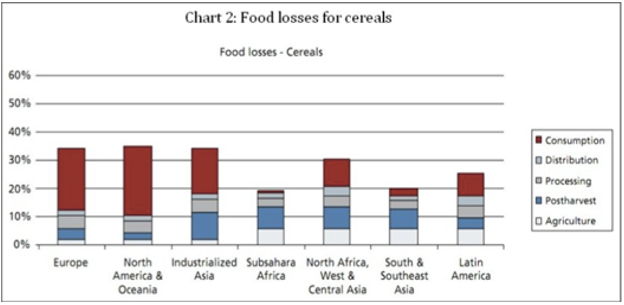Stop Food Wastage

Economic times survey had indicated a growth of meagre 1.1% in agricultural output last year. While the 12th five year plan had aimed to increase output @ 4% per year, we have fallen behind. In order to achieve the target, agricultural output has to grow @ >7% per annum. Still, the estimated output of around 250 million ton is considered to be enough to feed the Indian population. Some other people also mention that the production is surplus. Whichever is true proves that India produces enough to feed its own population as of now.
However, there are some major challenges ahead. Firstly, the challenge to sustain growth in agricultural output. Report says that the possibility to increase arable land is low, as increasing industries will need more land. It is a fact and we cannot avoid that. The probable feasible, albeit extremely difficult solution is to increase yield per hectare. In 2013, India produced 42.57 billion tonnes of rice. The yield was just below 4 tonnes per hectare. Whereas, rice yield in Australia is more than 12 tonnes per hectare. 3 times as that of India. The story is similar in every single commodity. It seems that we are maintaining the output by the virtue of sheer numbers. The question is, will it not be late if we do not act immediately, not only to quench our thirst, but also to remain self sufficient to feed our population in future?
Experts have cited various reason behind poor yield per hectare. The effort of the Govt. has been to improve on these aspects. Recently Govt. has decided to set up an exclusive ₹ 200 Billion fund for irrigation, though NABARD. An unified agricultural platform has also been planned. ₹ 1 billion has been allowed to states for Soil Health Card. The Govt has taken an immensely difficult target to cover 140 billion farms under this. Most importantly, the Govt. has taken a target to double the income of the farmers in next 5 years. The Govt. has planned to bring 585 mandis under National Electronic Market (NAM) by 2018. After boasting about building 17 km of roads per day, we can hope to brag about building 17 km of canals per day. The Govt. has planned a lot. The success will depend on the efficiency in implementation. 84% increase in budget allocation is a big step. It indicates that the Govt. has realised the urgency. It is now looking beyond food security.
Irony is, while we are speaking about 'beyond food security', food inflation continues to bug us. Worse still, India is ranked 25th is Global Hunger Index. Last year, it was ranked 69th. India accounts for more than 25% of the malnourished population of the world. As per report of Unicef, more than 40% of children in India are malnourished and it accounts for about 50% of Infant Mortality Rate in India.
This indicates a gap. If the production is more than or equal to the demand, ideally, inflation should have been very low, if not zero. And we would not have had appeared in the list of Global Hunger Index.
Experts cite the reason to be wastage.
As per United Nations Development Program, India wastes 40% of the food it produces! Food worth ₹ 580 billion is wasted in India every year. Wastage occurs due to inefficiencies or shortages of infrastructure in harvesting, transportation and storage. 100% FDI in food processing has been allowed in this budget and our minister of food processing has indicated that this is an effort towards reducing wastage. Any effort is appreciable.
However, there are other issues which need similar (or more) enthusiasm to resolve.
India produces more than 180 million tonnes of vegetables, fruits and other perishable items and has capacity to store only ~25 million tonne. Of these cold storages whose accumulated capacity is to store 25 million tonnes of products, 80% is used only for potatoes.
In order to promote investment in cold chain, Govt. had allowed FDI in retail. The retail sector, however has not shown much interest in investing in cold storages yet. Whether the food processing industry will be interested in investing in cold chain remains a big question.
Even if FDI in food processing industry enables investment and improvement in cold chain, it will be limited to fruits, vegetable and perishables. The fruits which are wasted now due to lack of storage will probably used to produce jams, jelly and juices. Unfortunately, these will not eliminate hunger and we have to turn our attention towards the need of reducing wastage of cereals.
A report indicates that more than 50% of the wastage of cereals in our region, occurs during agriculture and post-harvest stage. Followed by wastage during processing and consumption and lowest during distribution.
We are yet to hear anything from the Govt. regarding policies to renovate storage facilities of FCI where thousands of tonnes of cereals are wasted by pests and rodents. Neither do we hear of any policies to promote technologies in farm to reduce wastage till harvesting.
In 2008, a New York Times article stated that with the right technology and policies, India could help feed the world. Let the nation rise up to its potential and exceed the anticipated. To start with, even if the Govt. does not come up with any related policies, at personal level, if we can start avoiding wastage of food, it will not be a bad start. We can save about 4 million tonnes of cereals that way!